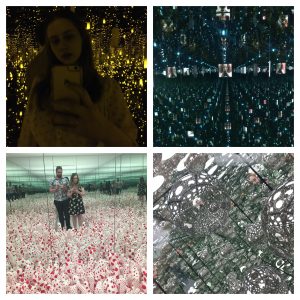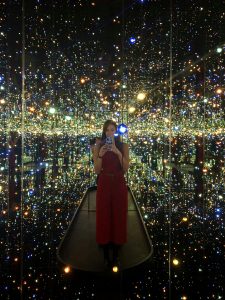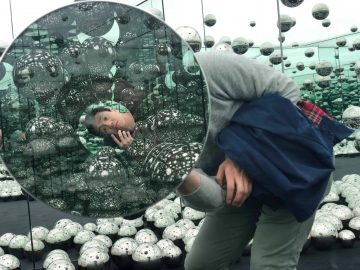Introduction to the Infinity Mirrors
In 2018, the Art Gallery of Ontario launched a crowdfunding campaign to buy a new work of art. This new form of funding raised questions, concerns and praises for the future of museum funding.
From March to May 2018, the Art Gallery of Ontario (AGO) hosted a solo-exhibition of Japanese-born artist Yayoi Kusama’s work – a prolific artist whose career has spanned over 65 years. The exhibition, Infinity Mirrors, generated widespread interest, with tickets capped at four-per-person, creating massive online wait times for purchases. Kusama is a well-established visual artist, known for her meticulous, often-whimsical and transcendent instillation pieces. The popularity of this exhibition was unparalleled, with the AGO predicting long wait times for entry even for ticket holders. Each ticket holder would be allowed a maximum of 30 seconds in each room; creating a great deal of anticipation to capture these moments with photography. Over 165,000 people visited the exhibition; with visitors posting thousands of photos of the exhibit- including selfies in the various mirrored rooms- on social media.

Various selfies taken in Infinity Mirrors. Photos courtesy of (from top left corner going clockwise) Jane Baker, Vannessa Barnier, Christin Gillard and Joseph Drake.

Erica Chi’s selfie in Infinity Mirrors. Image courtesy of Erica Chi.
A short six months after the exhibition closed, the AGO announced in a press release that they were launching a crowdfunding campaign to purchase one of Kusama’s Infinity Mirror Rooms, entitled Let’s Survive Forever. The AGO had the intention to include the work in the gallery’s permanent collection. The goal: 1.3 million dollars. The timeline: 30 days.
The campaign
“#InfinityAGO campaign invites Toronto to help bring Canada’s first Infinity Mirror Room to the AGO… for infinity. Donors to be first to experience the artwork”[.]
The AGO managed to initially source $1 million for the Kusama before announcing the campaign. At the end of the 33-day window, the AGO ended up raising roughly half of their target, $648,817. In hindsight, the $650,000 crowdsource was the first of its kind for a Canadian gallery. This promising crowd donation may spell out a new way to think about art, museums and audiences.
What is crowdfunding?
Crowdfunding, which has gained popularity thanks to websites like Kickstarter, GoFundMe and Patreon, is a practice where organizations or individuals set out to raise money from people online. It can be thought of like a public donation; in one sweeping motion, the small monetary donations from thousands of people, the ‘crowd’, accumulate to ‘fund’ a project or person. The AGO is the first Canadian art institution to look to the public for funding a new buy; breaking the ice for new opportunities for public engagement in galleries.
What are we doing when we ask for crowdfunding? How does this differ from the traditional funding model?
Crowdfunding relies on factors such as popularity, scope, promotion and outreach. It requires either a pre-established audience of donors or the amassing of donors through social media platforms. In the case of the AGO, the popularity of the Kusama exhibition helped drive the campaign into the public eye. With a hastag, #InfinityAGO leading the way, this crowdfunding campaign was poised to encourage visitors who do not typically make donations to the AGO to participate. Essentially, the widely known gallery is asking those who want to contribute a small piece of their income (donations can be low as $1 on some platforms) to come together to fund a piece of permanent artwork.

Phil So’s selfie in Infinity Mirrors. Photo courtesy of Phil So.
Traditional funding envelopes for institutions like the AGO are a combination of government (both provincial and federal) grants, private donations, corporate sponsorship and admission fees or memberships. Private sector spending in museums is not new; in fact, many institutions around the world are direct products of this private or corporate money – obvious in the donor names that are present on the walls of museums.
How will these kinds of crowdfunded movements change our funding models?
There has been plenty of controversy around the use of private or corporate money to fund institutions.
The British Museum’s long standing funder is British Petrol (BP); a relationship which was widely protested earlier this year.
The Sackler family, better known as the owners of pharmaceutical company Purdue Pharma, the developers of OxyContin, have been funding arts institutions in North America for decades. OxyContin is a controversial pharmaceutical drug; it is extremely addictive and is often to blame as one of the root causes for the current opioid crisis. Many institutions now, including the Guggenheim in New York and the National Portrait Gallery in London, have been turning down any further donations from the Sacklers. The Sackler family is facing many lawsuits and institutions are now rethinking their ethical stances on accepting monetary gifts.
In Canada, there has been controversy around the Canadian Museum of History in Ottawa, which has received funding in the past from oil lobbyist company Canadian Association of Petroleum Producers.
With social consciousness shifting towards an understanding that big money can potentially be sourced from environmentally or socially detrimental companies, perhaps the crowdfunding model can be a saving grace. By empowering the museums’ visitors to help fund the purchase of pieces that they want to see, museums have a chance to engage with visitors in a way that has not been possible before. By breaking down those barriers, removing in part the need for corporate sponsorships, perhaps once-exclusionary institutions can begin to be more open, honest and socially minded by inviting their visitors to be a part of the decision and funding process.
___
To our readers: in light of a recent incident that Kusama had with writer Dexter Thomas, I thought it would be important to place Thomas’ article here at the end of this article.
Written by: Defne Inceoglu
Edited by: Eseohe Ojo

